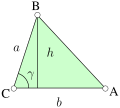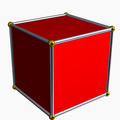Edge (geometry)
-
A polygon is bounded by edges; this square has 4 edges.
-
Every edge is shared by three or more faces in a 4-polytope, as seen in this projection of a tesseract.
- For edge in graph theory, see Edge (graph theory)
기하학(geometry)에서, 가장자리(edge)는 다각형(polygon), 다면체(polyhedron), 또는 고-차원 폴리토프(polytope)의 두 꼭짓점(vertices)을 연결하는 선분(line segment)의 특정 유형입니다.[1] 다각형에서, 가장자리는 경계의 선분이고,[2] 종종 변(side)이라고 불립니다. 다면체 또는 보다 일반적으로 폴리토프에서, 가장자리는 두 면(faces)이 만나는 선분입니다.[3] 내부 또는 외부를 통과하면서 두 꼭짓점을 연결하는 선분은 가장자리가 아니고 대신에 대각선(diagonal)이라고 불립니다.
Relation to edges in graphs
그래프 이론(graph theory)에서, 가장자리(edge)는 선분으로 구체적인 기하학적 표현을 가지는 다각형과 다면체 모서리와 달리 둘의 그래프 꼭짓점(graph vertices)을 연결하는 추상적인 대상입니다. 어쨌든, 임의의 다면체는 그것의 뼈대(skeleton) 또는 가장자리-뼈대, 그것의 꼭짓점이 다면체의 기하학적 꼭짓점이고 그것의 가장자리가 기하학적 가장자리에 해당하는 그래프에 의해 표현될 수 있습니다.[4] 반대로, 삼-차원 다면체의 뼈대인 그래프는 정확히 3-꼭짓점-연결된(3-vertex-connected) 평면 그래프(planar graph)로 슈타이니츠의 정리(Steinitz's theorem)에 의해 특성화될 수 있습니다.[5]
Number of edges in a polyhedron
임의의 볼록 다면체(convex polyhedron)의 표면은 오일러 특성(Euler characteristic)을 가집니다:
여기서 V는 꼭짓점(vertices)의 숫자, E는 가장자리의 숫자이고, F는 면(faces)의 숫자입니다. 이 방정식은 오일러의 다면체 공식(Euler's polyhedron formula)으로 알려져 있습니다. 따라서 가장자리의 숫자는 꼭짓점과 면의 숫자의 합보다 2 적습니다. 예를 들어, 정육면체(cube)는 8 꼭짓점과 6 면을 가지고, 따라서 12 가장자리를 가집니다.
Incidences with other faces
다각형에서, 두 가장자리는 각 꼭짓점에서 만납니다; 보다 일반적으로, 발린스키의 정리(Balinski's theorem)에 의해, 적어도 d 가장자리는 d-차원 볼록 폴리토프의 모든 각 꼭짓점에서 만납니다.[6] 유사하게, 다면체에서, 정확히 둘의 이-차원 면이 모든 각 가장자리에서 만나고,[7] 반면에 고차원 다면체에서 셋 이상의 이-차원 면이 모든 각 가장자리에서 만납니다.
Alternative terminology
고차원 볼록 폴리토프(convex polytope) 이론에서, d-차원 폴리토프(polytope)의 패싯(facet) 또는 변은 그것의 (d − 1)-차원 특징 중 하나이고, 릿지(ridge)는 (d − 2)-차원 특징이고, 피크(peak)는 (d − 3)-차원 특징입니다. 따라서, 다각형의 가장자리는 그것의 패싯이고, 3-차원 볼록 다면체(convex polyhedron)의 가장자리는 릿지이고, 4-차원 폴리토프(4-dimensional polytope)의 가장자리는 피크입니다.[8]
See also
References
- ^ Ziegler, Günter M. (1995), Lectures on Polytopes, Graduate Texts in Mathematics, vol. 152, Springer, Definition 2.1, p. 51.
- ^ Weisstein, Eric W. "Polygon Edge." From MathWorld--A Wolfram Web Resource. http://mathworld.wolfram.com/PolygonEdge.html
- ^ Weisstein, Eric W. "Polytope Edge." From MathWorld--A Wolfram Web Resource. http://mathworld.wolfram.com/PolytopeEdge.html
- ^ Senechal, Marjorie (2013), Shaping Space: Exploring Polyhedra in Nature, Art, and the Geometrical Imagination, Springer, p. 81, ISBN 9780387927145.
- ^ Pisanski, Tomaž; Randić, Milan (2000), "Bridges between geometry and graph theory", in Gorini, Catherine A. (ed.), Geometry at work, MAA Notes, vol. 53, Washington, DC: Math. Assoc. America, pp. 174–194, MR 1782654. See in particular Theorem 3, p. 176.
- ^ Balinski, M. L. (1961), "On the graph structure of convex polyhedra in n-space", Pacific Journal of Mathematics, 11 (2): 431–434, doi:10.2140/pjm.1961.11.431, MR 0126765.
- ^ Wenninger, Magnus J. (1974), Polyhedron Models, Cambridge University Press, p. 1, ISBN 9780521098595.
- ^ Seidel, Raimund (1986), "Constructing higher-dimensional convex hulls at logarithmic cost per face", Proceedings of the Eighteenth Annual ACM Symposium on Theory of Computing (STOC '86), pp. 404–413, doi:10.1145/12130.12172.
External links





